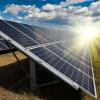
IIASA researchers contributed to the latest edition of the International Energy Agency (IEA)’s World Energy Outlook, which shows that there are set to be almost 10 times as many electric cars on the road, renewables are nearing half of the global power mix, and much stronger policies are needed to achieve the 1.5°C target of the Paris Agreement.
Major shifts underway today are set to result in a considerably different global energy system by the end of this decade, according to the IEA World Energy Outlook 2023. The phenomenal rise of clean energy technologies such as solar, wind, electric cars, and heat pumps is reshaping how we power everything from factories and vehicles to home appliances and heating systems.
The latest edition of the World Energy Outlook (WEO), a premier global source of energy analysis and projections for industry professionals, describes an energy system in 2030 in which clean technologies play a significantly greater role than today. This includes almost 10 times as many electric cars on the road worldwide; solar PV generating more electricity than the entire US power system does currently; renewables’ share of the global electricity mix nearing 50%, up from around 30% today; heat pumps and other electric heating systems outselling fossil fuel boilers globally; and three times as much investment going into new offshore wind projects than into new coal- and gas-fired power plants.
All of these increases are based only on the current policy settings of governments around the world. If countries deliver on their national energy and climate pledges on time and in full, clean energy progress would move even faster. However, even stronger measures would still be needed to keep alive the goal of limiting global warming to 1.5 °C.
The combination of growing momentum behind clean energy technologies and structural economic shifts around the world has major implications for fossil fuels, with peaks in global demand for coal, oil and natural gas all visible this decade – the first time this has happened in a WEO scenario based on today’s policy settings. In this scenario, the share of fossil fuels in global energy supply, which has been stuck for decades at around 80%, declines to 73% by 2030, with global energy-related carbon dioxide (CO2) emissions peaking by 2025.
IIASA researchers from the Biodiversity and Natural Resources (BNR) worked with the IEA on the modelling and analysis of greenhouse gas emissions and removals from land use, agriculture, and bioenergy production using the Global Biosphere Management Model (GLOBIOM).
“Reducing deforestation to net-zero by 2030 - in line with the Glasgow Leaders’ Declaration on Forests and Land Use – provides the largest share of CO2 emissions reductions from the land‐use sector and is a key action needed to keep alive the goal of limiting global warming to 1.5°C," notes Nicklas Forsell, a researcher in the Integrated Biosphere Futures Research Group of the IIASA Biodiversity and Natural Resources Program.
IIASA researchers from the Energy, Climate, and Environment programs also worked with the IEA to analyze the impact of energy-related policies on pollutants using data from the IEA and the IIASA Greenhouse Gas Air Pollution Interactions and Synergies (GAINS) model to study emissions from the energy sector and assess the effectiveness of existing policies and technologies in reducing air pollutants. The analysis covered both global and regional emissions, including non-energy sources like agriculture and waste, to understand their impact on air quality.
As things stand, demand for fossil fuels is set to remain far too high to keep within reach the Paris Agreement goal of limiting the rise in average global temperatures to 1.5 °C. This risks not only worsening climate impacts after a year of record-breaking heat, but also undermining the security of the energy system, which was built for a cooler world with less extreme weather events. Bending the emissions curve onto a path consistent with 1.5 °C remains possible but very difficult. The costs of inaction could be enormous: despite the impressive clean energy growth based on today’s policy settings, global emissions would remain high enough to push up global average temperatures by around 2.4 °C this century, well above the key threshold set out in the Paris Agreement.
The WEO-2023 proposes a global strategy for getting the world on track by 2030 that consists of five key pillars, which can also provide the basis for a successful COP28 climate change conference. They are: tripling global renewable capacity; doubling the rate of energy efficiency improvements; slashing methane emissions from fossil fuel operations by 75%; innovative, large-scale financing mechanisms to triple clean energy investments in emerging and developing economies; and measures to ensure an orderly decline in the use of fossil fuels, including an end to new approvals of unabated coal-fired power plants.
Implementing such decarbonization measures would also bring health benefits by enhancing air quality: “The net-zero pathway, combined with strong air pollution controls, reduces total air pollution related premature deaths by more than 50% in 2030, or 3.5 million cases per year, compared to the scenario reflecting current policies only. This would be an important step towards achieving multiple sustainable development goals, including health, clean energy access, and livable cities,” notes Gregor Kiesewetter, a senior research scholar in the Pollution Management Research Group of the IIASA Energy, Climate, and Environment Program.
Adapted from a press release by the International Energy Agency. Read the original text here.
Further information
News

06 March 2025
Crafting narratives for a resilient and coherent Trans-European Nature Network

18 December 2024
Celebrating a year of impact: IIASA highlights in 2024

12 December 2024


